This website uses cookies to improve user experience. By using our website you consent to these cookies being used in accordance with our cookie policy.
Register
Log in
Welcome to Kerry Wines!
With a maze of appellations and fragmented vineyards, Burgundy may appear to be complicated for many wine lovers; however it offers a treasure of world-famous red and white with nuanced wine styles reflecting its terroir.
Wine has been made in Burgundy for over 2000 years, first by the Celts, and then expanded under Roman rule. However, it’s the monks living in the numerous monasteries that sprang up after the 6th century who first developed a systematic method to work the vines, and to define and improve various plots of lands suitable for growing grapes.
With 27,600 hectares under vine, Burgundy enjoys a northern continental climate with hot summers and severe winters. Even though several grapes varieties exist, Chardonnay and Pinot Noir are without doubt the emblematic grapes of the region, producing top whites and reds that have become the benchmarks for other parts of the world.
Burgundy has 100 appellations, on four levels of increasing quality: Regional, Village, Premier Cru and Grand Cru. Across 230km long from North to South, there are 5 key areas in Burgundy.
In the north of Burgundy where the Yonne region is located, Chablis produces the crispest white with mouthwatering acidity. The wines range from basic Chablis, to Chablis Premier Cru and Chablis Grand Cru. Chablis Grand Cru needs ageing to show its best. In the best sites the soil is limestone overlaid with a layer of Kimmeridgian clay which is rich in marine fossils, contributing the minerality of the wines. Petite Chablis is located in lesser vineyards on Portlandian clay.
Heading south we reach the great Burgundy districts of the Côte d’Or, or “golden slope”, which is split into two. The north part is Côte de Nuits. The word “Nuits” literally means the “nights”. It is where most of the fullest bodied and longest-lived reds are found. Except one (Corton), all the red Grands Crus are produced here. Key villages are Chambolle-Musigny, Gevrey Chambertin, Vougeot, Vosne-Romanée and Nuits-St.-Georges.

Chardonnay is the king in the Côte de Beaune area, from where seven of Burgundy’s eight white Grands Crus are produced. Key villages such as Aloxe-Corton, Meursault, Puligny-Montrachet and Chassagne-Montrachet, produce the richest, most complex and longest-lived whites in the world, with their reds always living under their shadow. Whereas Volnay and Pommard are producing great reds on par with their Côte de Nuits counterparts.
Côte Chalonnaise is home to many of Burgundy’s good value and lesser-known wines with 5 appellations including Bouzeron, Rully, Montagny, Mercurey and Givry..
Located further south, the Mâconnais interlaces with Beaujolais to the south. Covered with limestone soil, it is essentially a white-wine producing area. The most famous village Pouilly-Fuissé produces ripe and full bodied whites with stone and tropical fruits and buttery notes from barrel ageing, whereas Viré-Clessé and Saint-Véran have their own appellations.